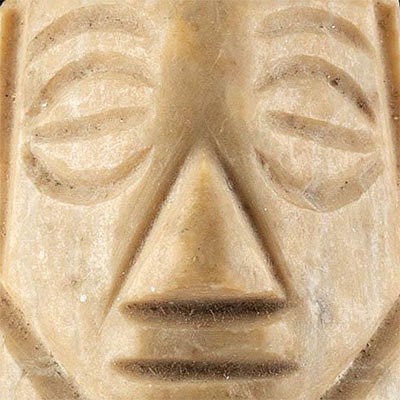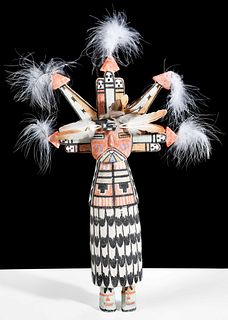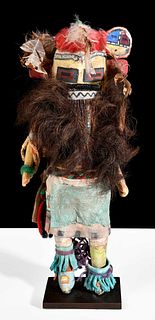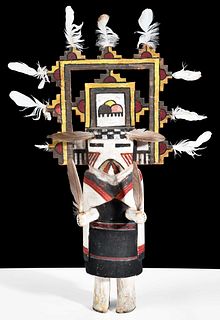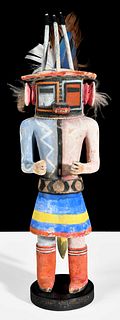Lot of 3 Early 20th C. Togo Ewe Wood Figures
Lot 97
About Seller
Artemis Gallery
686 S Taylor Ave, Ste 106
Louisville, CO 80027
United States
Selling antiquities, ancient and ethnographic art online since 1993, Artemis Gallery specializes in Classical Antiquities (Egyptian, Greek, Roman, Near Eastern), Asian, Pre-Columbian, African / Tribal / Oceanographic art. Our extensive inventory includes pottery, stone, metal, wood, glass and textil...Read more
Categories
Estimate:
$800 - $1,200
Absentee vs Live bid
Two ways to bid:
- Leave a max absentee bid and the platform will bid on your behalf up to your maximum bid during the live auction.
- Bid live during the auction and your bids will be submitted real-time to the auctioneer.
Bid Increments
| Price | Bid Increment |
|---|---|
| $0 | $25 |
| $300 | $50 |
| $1,000 | $100 |
| $2,000 | $250 |
| $5,000 | $500 |
| $10,000 | $1,000 |
| $20,000 | $2,500 |
| $50,000 | $5,000 |
| $100,000 | $10,000 |
| $200,000 | $20,000 |
About Auction
By Artemis Gallery
Jun 3, 2021
Set Reminder
2021-06-03 12:00:00
2021-06-03 12:00:00
America/New_York
Bidsquare
Bidsquare : It's a Small World | Diminutive Artifacts
https://www.bidsquare.com/auctions/artemis-gallery/its-a-small-world-diminutive-artifacts-7031
Join us for a very special auction featuring art & artifacts from East to West, North to South, and everywhere in between - with one small thing in common - size! Everything in this auction is approximately 6 inches or less - perfect for that last bit of shelf space in your curio cabinet! Artemis Gallery info@artemisgallery.com
Join us for a very special auction featuring art & artifacts from East to West, North to South, and everywhere in between - with one small thing in common - size! Everything in this auction is approximately 6 inches or less - perfect for that last bit of shelf space in your curio cabinet! Artemis Gallery info@artemisgallery.com
- Lot Description
Western Africa, Togo, Ewe people, ca. early to mid 20th century CE. A fine trio of hand-carved wooden figures representing two nude men and a woman. Each is similarly shaped with delineated legs standing on integral platforms, and arms hanging to the sides. The largest man has a tall neck with a rounded head and stylized features. The female figure has protruding cylindrical breasts and broad shoulders; her visage presents with bulging eyes and an elaborate coiffure. A strand of colorful seed beads is wrapped around her waist, and may have been added at a later time. The last is a small male figure with thick arms, and a bulbous head with large semicircular eyes. Dolls like these examples are called "venovi" or "venavi" and the Ewe have traditionally carved such figures for protection following the death of a twin. Ewe women care for such dolls by cleaning and 'feeding' them, and at times even using such dolls as a replacement child. The wood of all three has developed a smooth patina, perhaps resulting from a loving mother's touch. Size (largest man): 3.5" W x 7.25" H (8.9 cm x 18.4 cm); (smallest): 3" W x 6.5" H (7.6 cm x 16.5 cm)
Provenance: private New York, New York, USA collection; ex-collection of Dr. Edward A. Spiegel (1931-2020) professor of astronomy at New York University and Columbia University who worked on convection theory and on the application of fluid dynamics to astrophysics and was the first to discover Chaos Theory. As a professor, students enjoyed his accounts of his meetings with other famous scientists such as Paul Dirac and Stephen Hawking.
All items legal to buy/sell under U.S. Statute covering cultural patrimony Code 2600, CHAPTER 14, and are guaranteed to be as described or your money back.
A Certificate of Authenticity will accompany all winning bids.
We ship worldwide and handle all shipping in-house for your convenience.
#161313Woman is repaired with both arms reattached at shoulders. There is some visible adhesive residue and loss to base. Stable fissure to back side of largest man, abrasions to back of head, and scratches and nicks to body. Smallest man has losses to base and a stable fissure that radiates from front side of torso to back side, and abrasions to high pointed areas. All have a nice patina.Condition
- Shipping Info
-
All shipping is handled in-house for your convenience. Your invoice from Artemis Gallery will include shipping calculation instructions. If in doubt, please inquire BEFORE bidding for estimated shipping costs for individual items.
-
- Buyer's Premium



 EUR
EUR CAD
CAD AUD
AUD GBP
GBP MXN
MXN HKD
HKD CNY
CNY MYR
MYR SEK
SEK SGD
SGD CHF
CHF THB
THB






